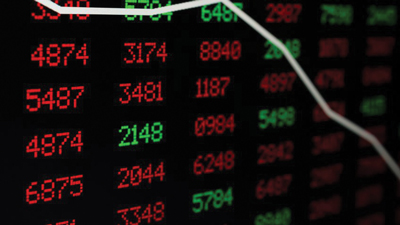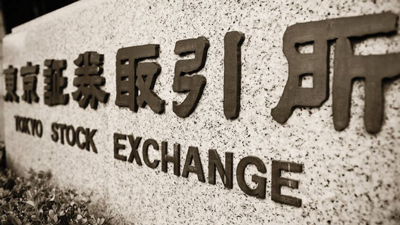By Roger Wohlner
The world of investing might seem like a glamorous one — after all, billionaires from Warren Buffett to Carl Icahn have made bank in this biz. Still, joining the ranks of the Wall Streeters requires a good deal of research. Along with seeking out investment tips from the pros, you should do your homework regarding common stock market myths.
If you want to succeed at the game of stocks and bonds and protect your portfolio for the long haul, take a look at these 25 investing recommendations that the experts say are really just myths.
It might be a popular belief that stocks are riskier than bonds, but it's not true, said Scott Trench, vice president of operations at investment website BiggerPockets. Rather, stocks are more volatile than bonds, he added.
"For any investor with a long-term, 30-year-plus outlook, it is almost a statistical certainty that you will be less wealthy investing in bonds than in stocks," he said.
"It's true that the price of stocks will likely fluctuate much more than bonds, as an asset class. However, the long term growth of stocks far outstrips the long term growth of bond investment returns."

If you think it's a solid plan to invest in a target date fund, set it and then forget it, think again. As your money grows, you'll need to diversify more than a target date fund can offer, said Nick Vail, co-founder and financial advisor with Integrity Wealth Advisors.
"Oftentimes, they don't align properly with your goals as you age," he said. "Also, your fund might be too aggressive or too conservative for you as time goes on. Are all investors alike? Do they all have the same risk tolerance? Of course not. TDFs have a place in investing, but they are not the be-all and end-all."

Although it's important to diversify your portfolio, as a strategy, it comes with certain caveats.
"Allocating your money across too many stocks doesn't work because when the market drops, all stocks drop, but when an individual stock does well, you won't have enough of it to affect your portfolio," said Brian Lund, freelance financial journalist for TD Ameritrade's The Ticker Tape and other publications.
Warren Buffett himself has said: "Diversification is protection against ignorance. It makes little sense if you know what you are doing." Rather than diversify, Buffett thinks it's better to be well informed about the industry you're investing in and choose your stocks accordingly.

One investing strategy involves buying whole life insurance. Unlike term life insurance, which is designed to protect your dependents for a limited coverage period, whole life insurance is a permanent, tax deferred policy offering lifelong value.
Over time, the cash value of a whole life insurance policy grows at a guaranteed rate. However, don't mistake it for a proper investment, said Kirk Chisholm, wealth manager at Innovative Advisory Group.
"I really hate this phrase because it is completely misleading," he said. "The end result is that you bought yourself a very expensive form of insurance that you could have probably bought for 75 percent less. Furthermore, if it was an investment, then why wouldn't some of the world's smartest investment geniuses invest heavily in whole life insurance?"

A recent Fidelity survey found that 51 percent of investors believe index funds are more stable than actively managed funds. Meanwhile, a fifth of investors surveyed believe stock index funds can protect them from market fluctuations. However, both index and active stock funds carry market risk meaning that returns follow the market.
"The average S&P 500 fund has experienced large swings in one year performance, whether that fund is active or passive," the Fidelity report noted.

Some investors might buy into the myth that it's beneficial to get out of stock holdings for a few months in the anticipation that equities will be flat during that time period, said Mitch Tuchman, managing director of investment firm Rebalance IRA.
"This belief is especially prevalent in the summer months — note the predictable pattern of 'sell in May and go away,'" he said. "However, this runs two important risks:
First, you will miss two or more quarterly dividend payments. For example, if you have $250,000 in a retirement fund, your dividend yield on an S&P 500 Index investment is $5,323 a year. If you pull out for half the year, you're leaving $2,662.50 on the table which could compound into $10,695 in the next 20 years that won't be yours if you don't collect."
Additionally, Tuchman said that those who sell seasonally miss out on gains.
Secondly, "For almost 50 years, stocks have put on about one percent during the summer months," he said. "The up summers averaged 5.6 percent, and the down summers averaged a negative 8 percent. But if we have a typical, truly average summer, that's another $2,500 you don't collect by being in cash."

Eight out of nine investors surveyed by Fidelity believe index funds offer more protection than active funds during a downturn. However, Fidelity's research shows otherwise.
"On average, actively managed, large cap stock funds lost less during recent bear markets than large cap index funds. Index funds, by seeking to match the market before fees, are exposed to similar market risk as the index," the Fidelity report found.
Therefore, active stock funds, which aim to outperform the market, might even be able to make up for any losses experienced during downturns and offer stronger returns in the long run, according to Fidelity.

In the short term, investment fees might not seem like a big deal. However, over the long term, fees can eat away at your investments.
"Fees are incredibly important over time," said Jacob Lumby, founder of personal finance blog Cash Cow Couple. "Small fees compounded over many years result in the potential for large losses."
Here's the impact of fees on an ending account balance over 30 years:
"Fees are one part of investing that investors can control," said Lumby. "Low cost index funds can be purchased for less than 0.10 percent in annual fees."

It's natural to feel panic when the market takes a downward turn, and although many investors know that it's best to stay invested in those times, panic can still get the better of them.
Fidelity's survey found that 77 percent of mutual fund investors believe that it's better not to try to time the market, and stay invested for the long haul. However, some will still find themselves selling to dodge short term losses which means they miss out on the long term gains.

Some investors might choose to forgo investing in funds in favor of having an investment manager. However, that doesn't necessarily guarantee better returns over time.
"Numerous peer reviewed studies have shown that investment managers fail to outperform a simple, low cost index fund over long periods of time," Lumby said.
"The managers that do well in one time period usually do poorly in the next, making it impossible to pick a winner ahead of time. [Instead] purchase low cost index funds and stay invested through the good times and bad."

Currently, registered investment advisors are held to a fiduciary standard which means that they must act in their clients' best interests. On the other hand, stock brokers are held to a lower standard, the suitability standard. This requires only that the investments recommended must be reasonable for their clients.
However, new Department of Labor fiduciary rules for retirement accounts go into effect on July 1, 2019. This will require all advisors who provide retirement investment advice to be held to a fiduciary standard, meaning they must put clients' best interests ahead of their own profits.

Despite the commercials touting the benefits of gold, opinions about its benefits as an investment vary. Gold is currently trading at $1,248 an ounce but the metal is still off its all time high of $1,864 an ounce set in September 2011. Gold can be a decent hedge. However, investing directly in the metal carries additional costs, like storage.

Morningstar assigns mutual funds a star rating that is based upon past performance and other metrics. Five stars is the highest ranking. However, these rankings of past performance are not meant to be predictors of future performance. Morningstar's analyst ratings do provide a forward looking analysis of mutual funds.

To most people, safe investments mean that they are "safe" from losing money or declining in value. Examples are bank savings accounts, CDs and money market funds. While these investments are safe, they offer very meager returns in today's low interest environment. People who are saving for long term goals, like retirement, face the prospect of losing purchasing power to inflation as a result of overexposure to safe investments.

Some investors believe that international investments offer too much risk. However, research from Fidelity shows otherwise.
Fidelity found that a portfolio with 70 percent U.S. stocks and 30 percent international equities offered less volatility than an all U.S. stock portfolio. Although this investment scenario hasn't performed as well in the past decade, Fidelity said it expects the situation to "revert to historical norms given the cyclicality of U.S. and international stock market performance."

"In the old days, trusts were written in a way that provided one beneficiary any income derived from the assets and another beneficiary any capital gains from the assets," said Christopher Carosa, chief contributing editor of FiduciaryNews.com and author of five books, including "Hey! What's My Number? How to Improve the Odds You Will Retire in Comfort."
He warns that the cost of acquiring stocks and bonds to produce sufficient income can be high in a low interest rate environment.
"If you rely solely on income, you either need to grow your assets faster than is reasonable, save more than is possible or end up living an unacceptably reduced lifestyle," he said.

17. U.S. Stocks Typically Perform Better Than Foreign Stocks
The belief that U.S. stocks perform better than foreign stocks is somewhat true. However, Fidelity noted that U.S. and international stocks outperform each other in cycles.
Recently U.S. stocks have performed better, but Fidelity said although the markets are difficult to time, it expected foreign stocks to "take the lead again" at some point.

Fidelity found that many U.S. companies with overseas operations have gone through periods in which their stock prices were highly correlated to the S&P 500's performance. Yet, when a stock price closely tracks the market, it usually means there is less diversification.
Fidelity noted a decrease in this trend, meaning U.S. multinational companies can offer better diversification, but it's still important to keep a mix of international stocks in one's portfolio.

When it comes to international investing, it's a common misconception that index funds will outperform active managers. However, Fidelity found that active managers, using skilled research analysts, can offer better performance over time, possibly because they've identified good opportunities.
Fidelity said that even after fees, actively managed, large cap international funds tend to beat the benchmark index by 0.86 percent yearly.

The "buy low, sell high" strategy is yet another myth that needs to be debunked, said Lund.
"The idea of 'buy low, sell high' is generally a myth because those terms are subjective," he said. "It should be 'buy high, sell higher,' because strong stocks tend to get stronger over time, and you should buy stocks in an uptrend, regardless of how 'high' they are."

Currency hedging is another strategy that can be challenging to achieve results with. To reduce the risk of unfavorable exchange rate shifts when holding a stock in foreign currency, investors should have an "equal but opposite position in the currency itself," according to Fidelty.
However, even professional investors have difficulty timing currency. And there's a level of effort and cost involved for returns that isn't necessarily significant, Fidelity noted, so the strategy might not be worth it.

Like many investing myths, this one comes with caveats. "First time funds outperform established venture funds, but returns are bifurcated. They tend to either turn out very well or turn out very badly," said Eric Daimler, CEO of SpinGlass, and Chris Moehle, managing director of The Robotics Hub.
Situations in which returns are good usually involve experienced venture capitalists, "not just early employees that won the stock option lottery," people with prior entrepreneurial experience and technical focus and expertise, they said.

It's a popular sentiment that Wall Street is essentially a casino that does not favor the individual investor. However, the data shows us that's just not true.
"Too often I have heard that you might as well go to Las Vegas as invest in Wall Street," said Robert R. Johnson, president and CEO of The American College of Financial Services. "Truth be told, the stock market is a positive sum game. That is, on average, the market advances and has done so for many years. The market goes up about two-thirds of the time and falls about one-third of the time when measured annually."
He pointed to stock data compiled since 1926 by Ibbotson Associates which shows that a diversified portfolio of large capitalization stocks, such as S&P 500, had a compounded average of 10 percent annually.

This is a commonly prescribed idea, but it might not be beneficial depending on the investor's situation, said Johnson.
"In actuality, the percentage of assets in equities should decline right before retirement, when an individual is in the retirement red zone, to protect individuals from sequence of returns risk," he said.
"Given other asset holdings, it might be appropriate for many investors to then increase equity holdings as they age." Know the difference between investing in stocks and in bonds so you choose the best investments for your situation.

Unfortunately, this myth must also be debunked. From 1928 to 2016, the average annual return of the S&P 500 was about 9.5 percent. Of course, the average return will vary widely during different periods of time. Investors should remember that long term averages are just that.
The return to an investor who holds an index fund tracking the S&P 500 or other investments will vary based on what portion of time he actually holds those investments for.
Long term average returns are deceiving and too often used to sell mutual funds and other investment vehicles. Instead, investors need to look behind any claims of outsized returns to fully understand what occurred and what it means.
